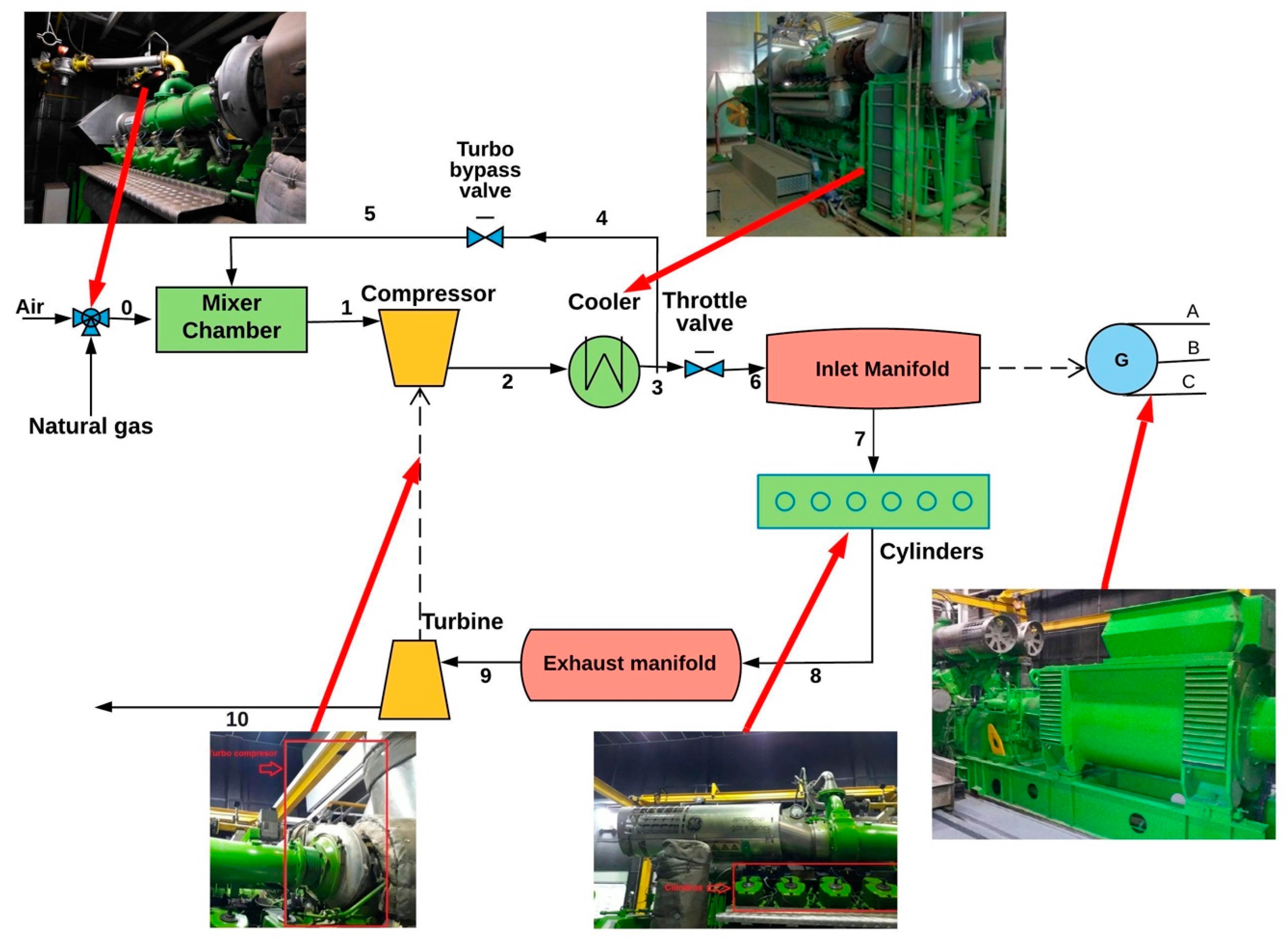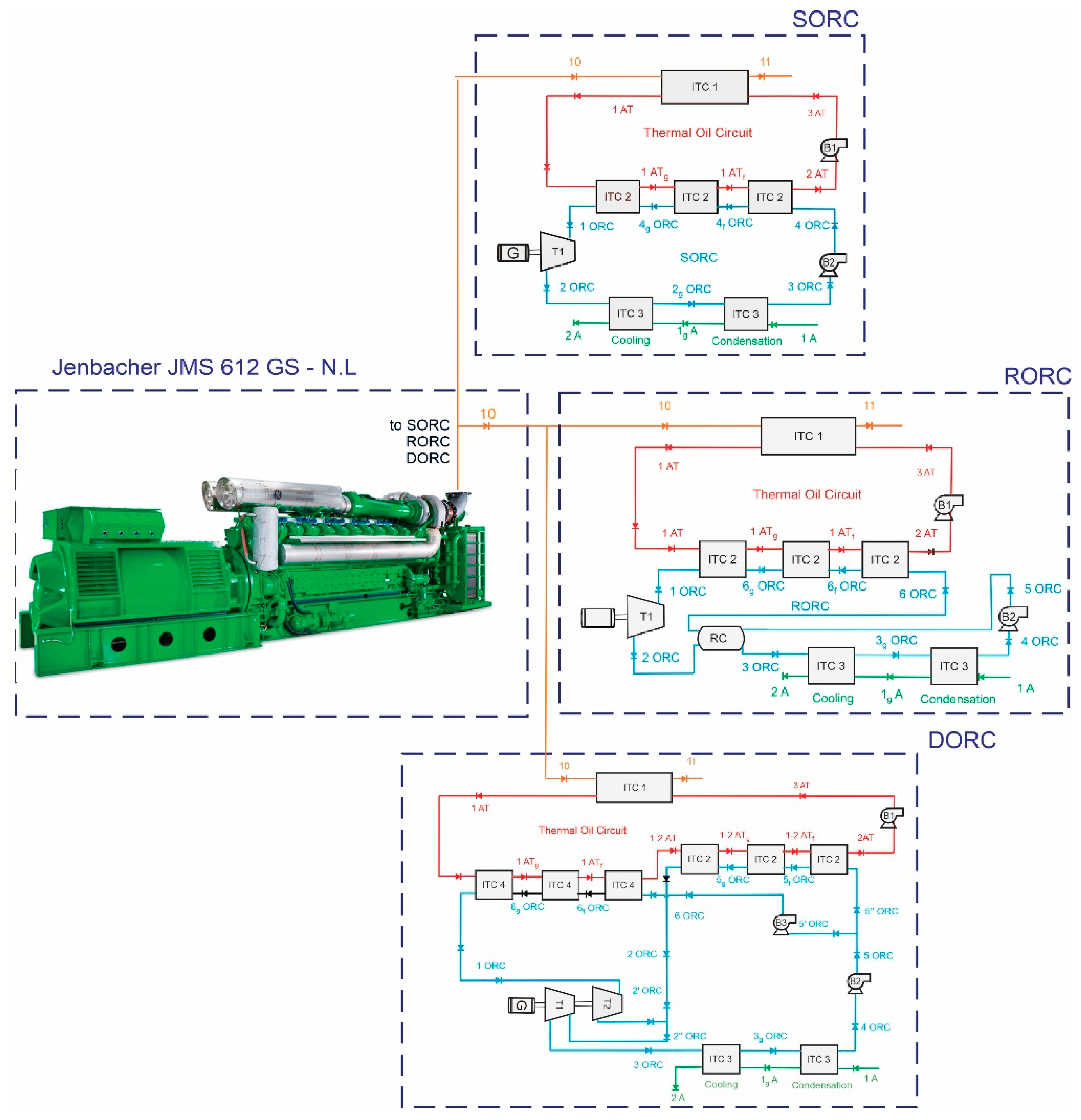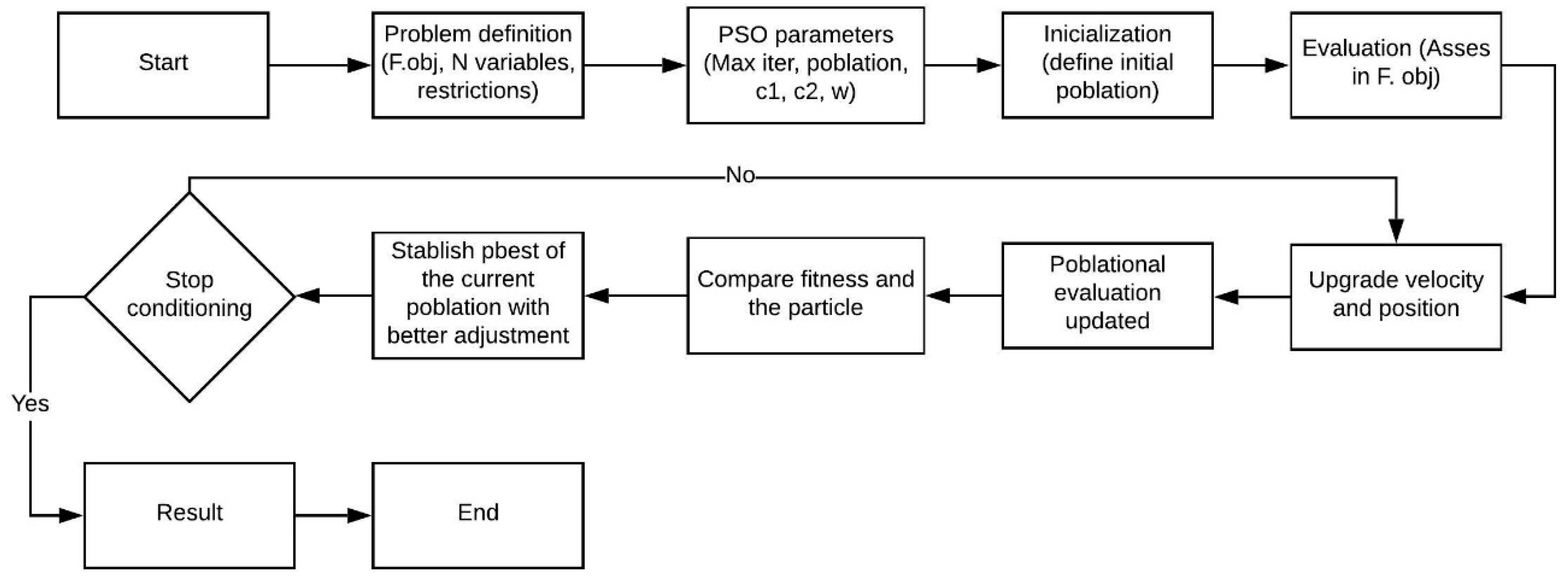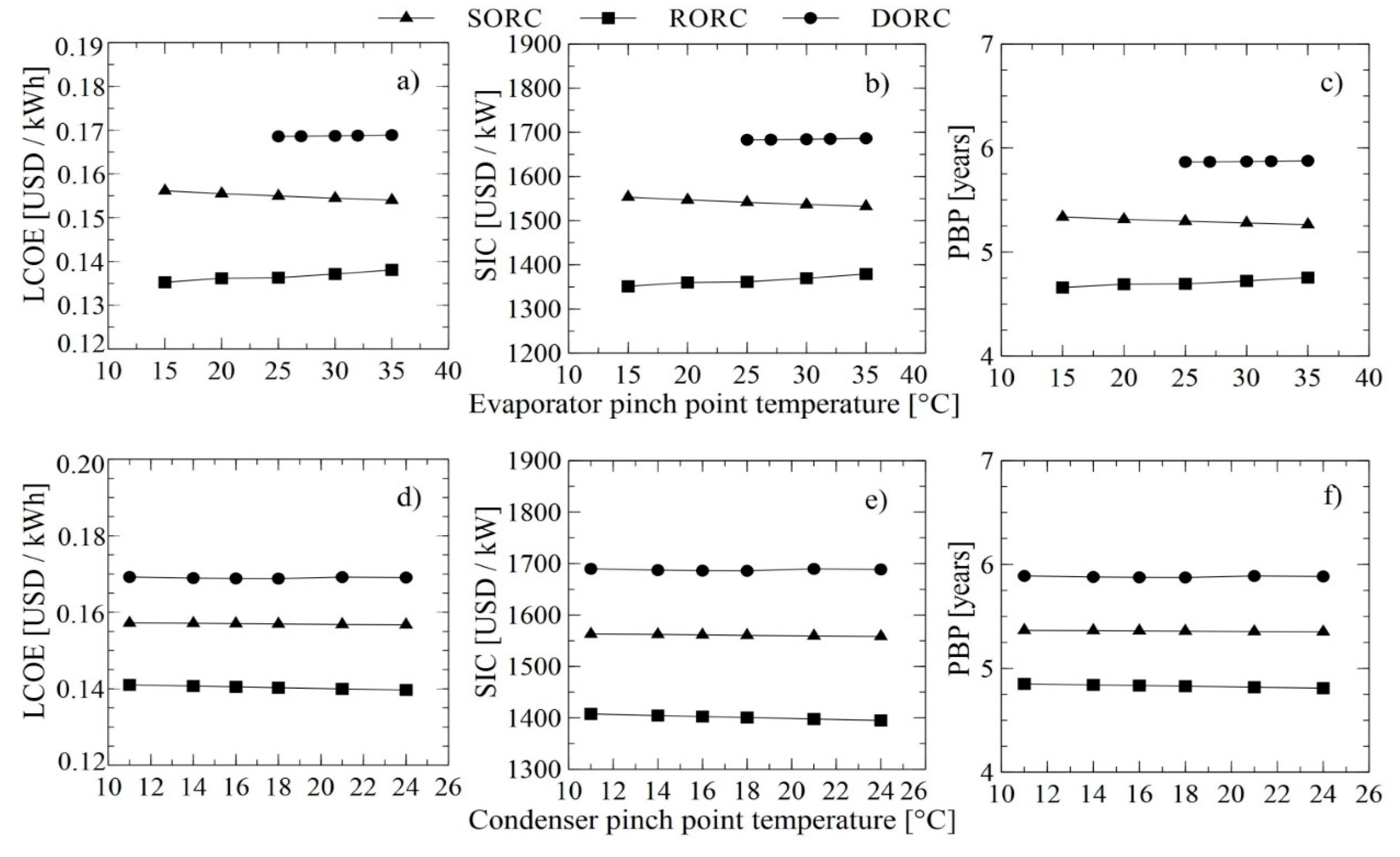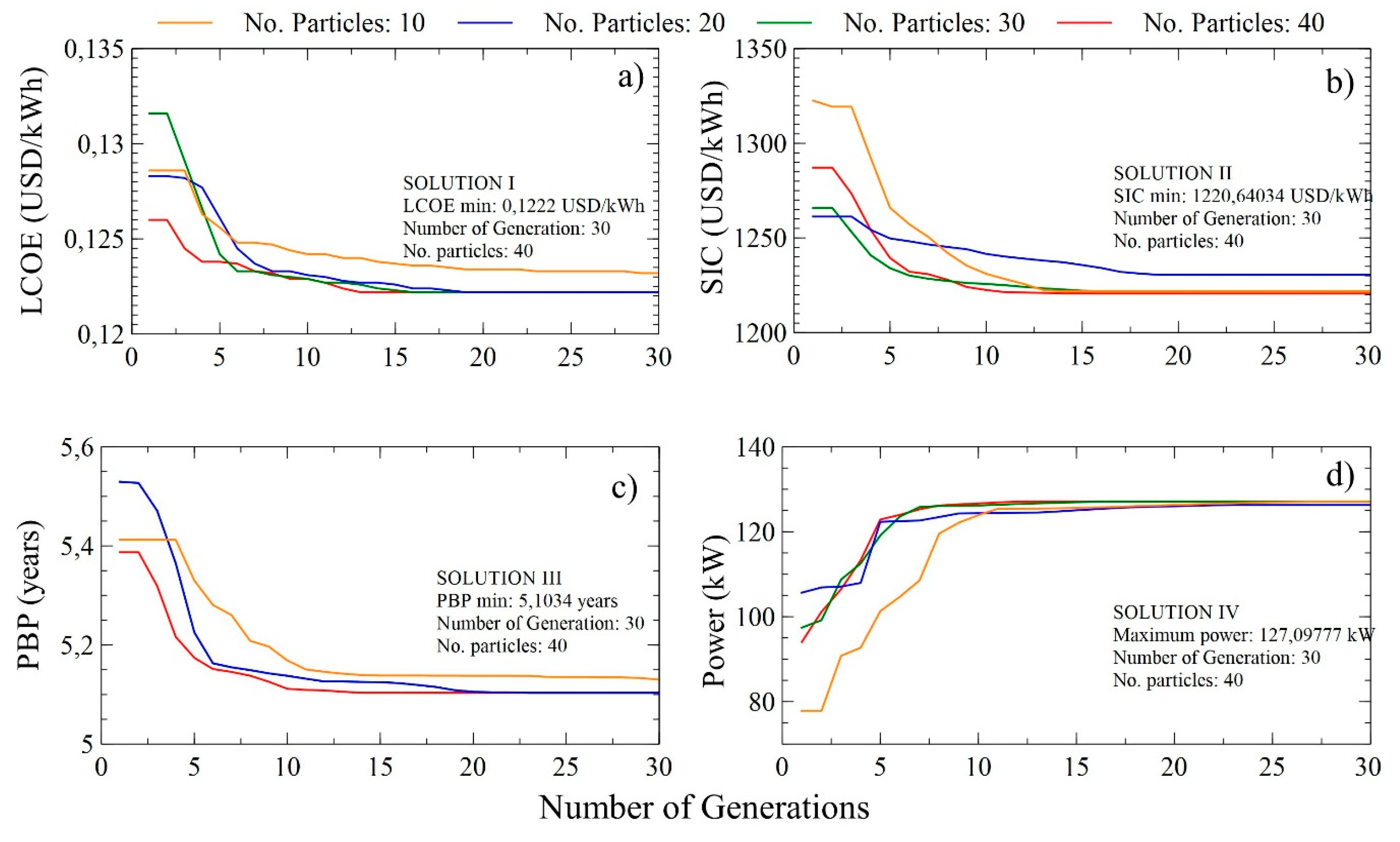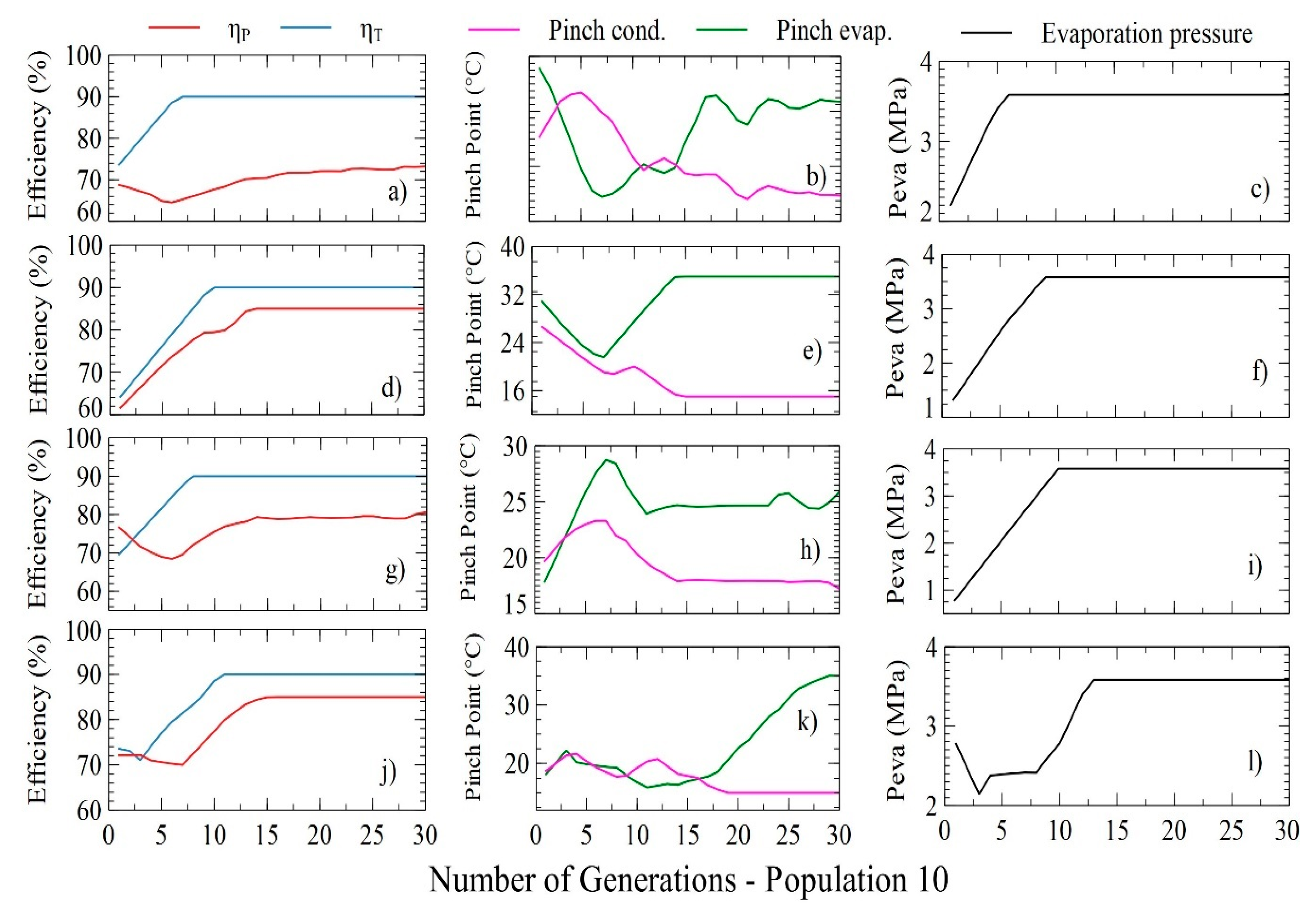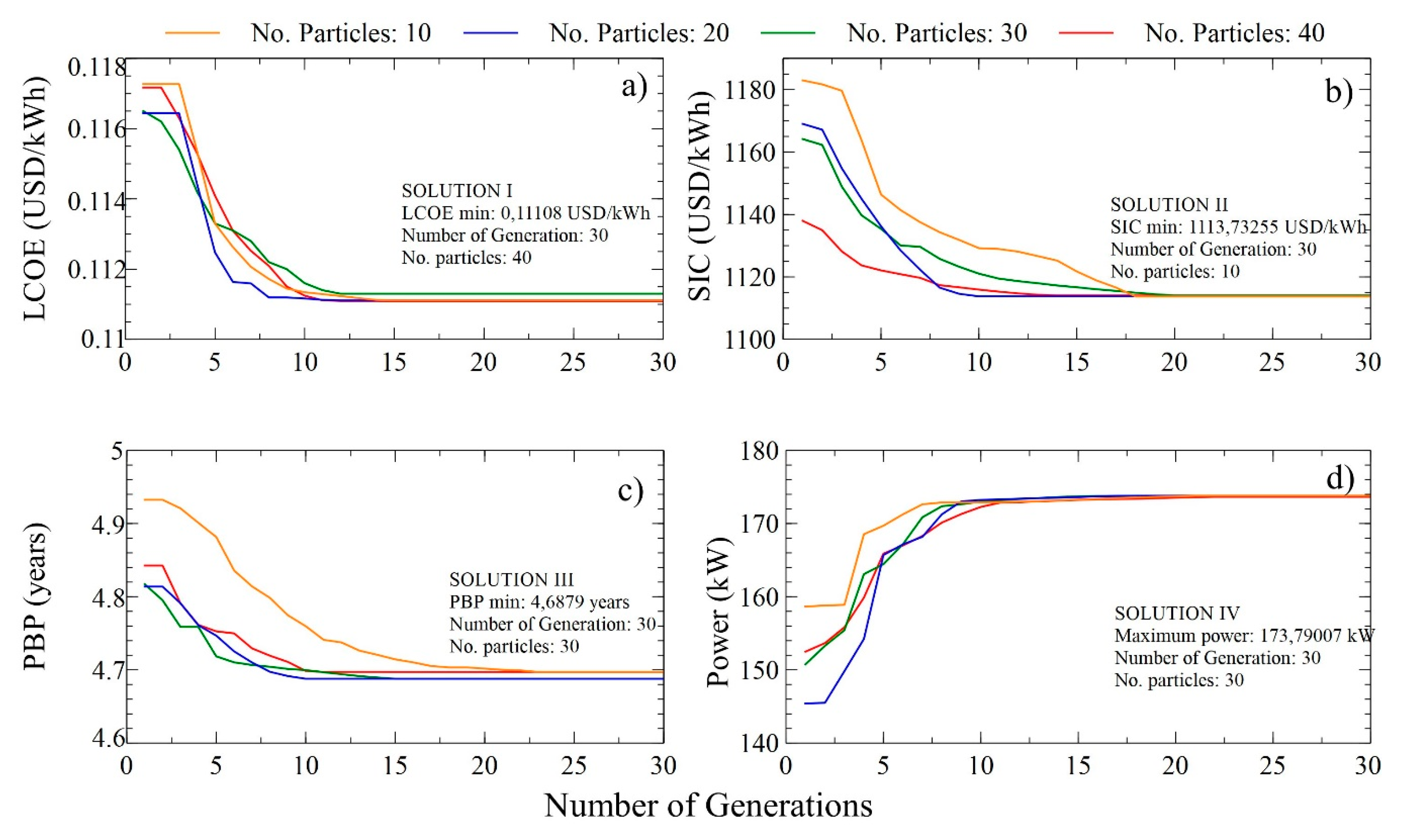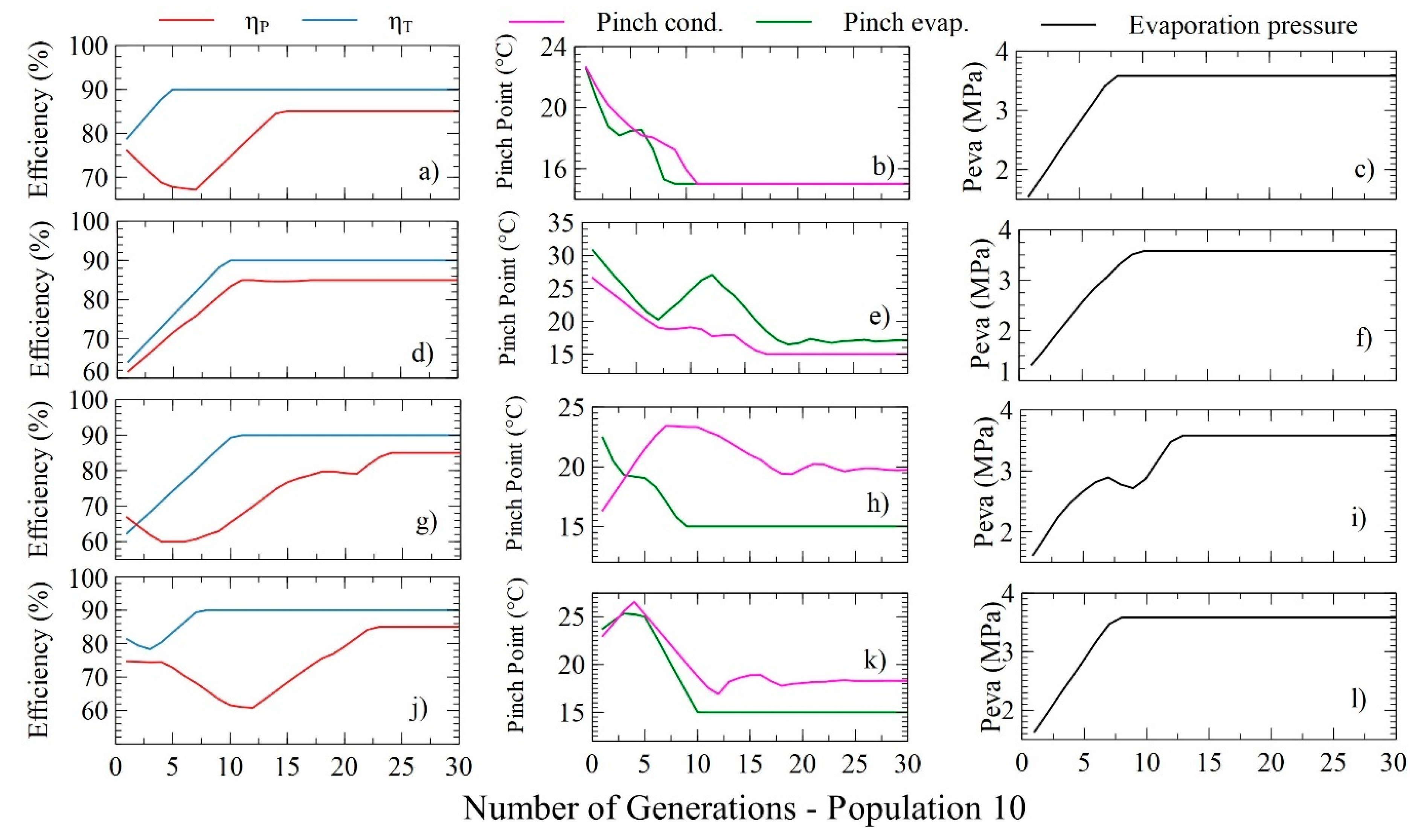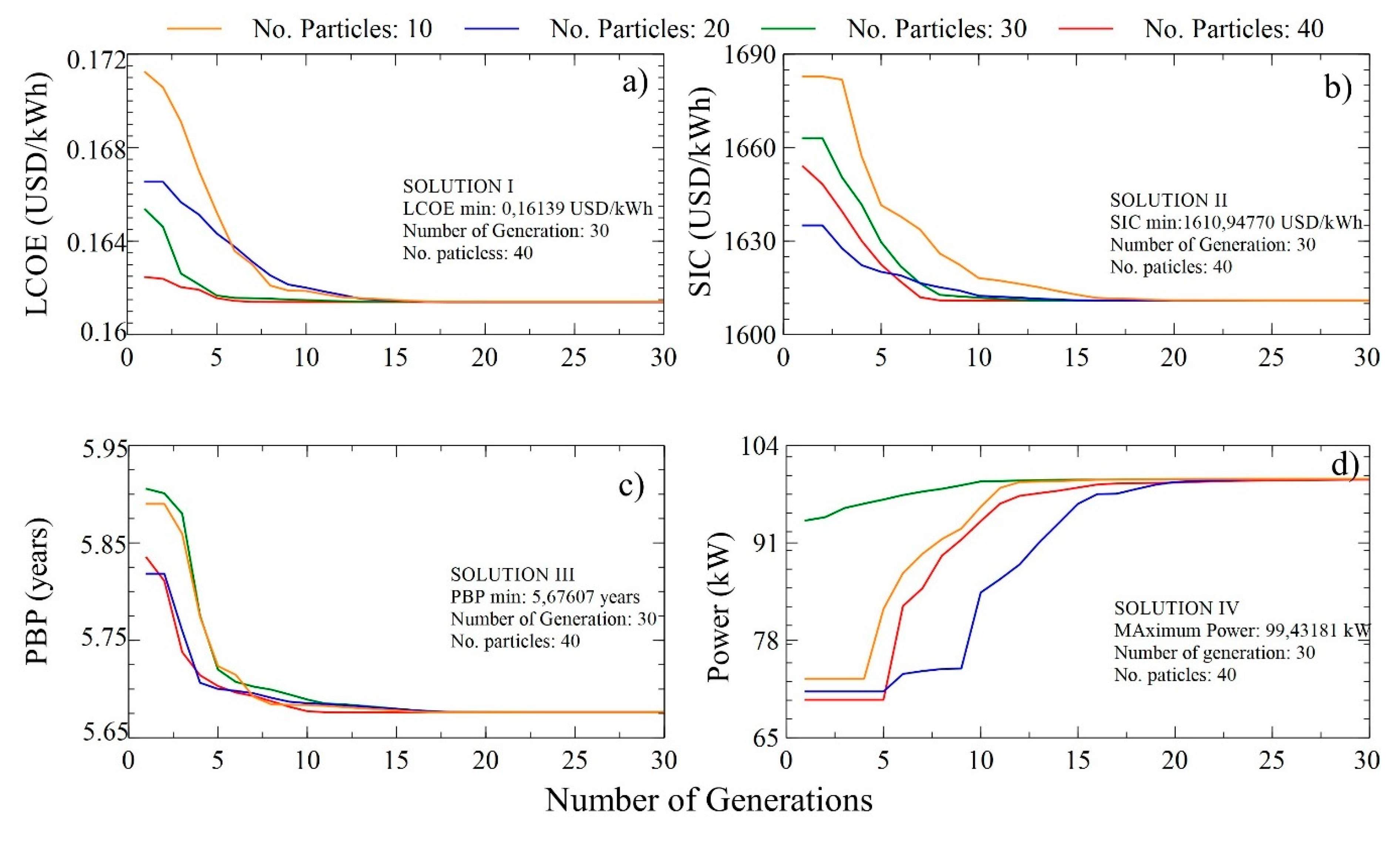1. Introduction
The extensive use of industrial generation engines worldwide, the low efficiency (which does not exceed 42%), and the potential of the waste gases generated, makes this thermal machine a central research issue [
1]. Several methods have been proposed to improve the efficiency of these engines. One has been the implementation of an organic Rankine cycle (ORC) as a waste heat recovery system from the exhaust gases, where the working fluids play an important role in the optimization study to obtain better performance in the process [
2,
3,
4].
In a power generation system, several thermodynamic cycles were implemented for waste heat recoveries, such as the ORC, the Kalina cycle, and the steam Rankine cycle. The complex structure of the Kalina cycle, the operational requirement of the steam Rankine cycle such as the high operating pressures and high risk of erosion, means the ORC cycle has the advantage given its simplicity, high reliability, and easy maintenance, which uses organic fluids for its operation. In addition, ORC is more suitable for using low and moderate energies (coolant engines and exhaust gases, for example) than the Kalina cycle and the steam Rankine [
5]. However, the different waste heat recovery configurations based on ORC cycle should be studied to be optimized under a thermoeconomic point of view for a particular heat source. Lion et al. [
6] present a complete thermodynamic study of a Winterthur Gas & Diesel’s marine diesel engine, which is alow-speed 6 MW of power, using Ricardo Wave simulation software (2018.1, Ricardo UK Ltd, United Kingdom). The model was validated by comparing the results with experimental data, an exhaust gas recirculation low-pressure architecture was implemented to measure engine performance within the framework of international maritime organization Tier III regulations, where the data obtained from the simulation were the inputs used in a thermodynamic model implemented in engineering equation solver, capable of quantifying the performance of the ORC, of evaluating the viability of the proposed system. From the results, it is observed that about 5% of annual fuel consumption would be saved for the system without ORC since improving the efficiency would help to maximize the fuel economy. This research is limited to a thermodynamic study of several ORC architectures, but thermoeconomic indicators were not considered in detail.
Additionally, Liu et al. [
7] proposed different modifications to the configurations of the ORC cycle and how to evaluate the performance of this cycle, where they presented ORC best practice, and with these proposed modifications a thermal efficiency of 18.57% was achieved, higher than the other models evaluated, thus the study provides to future researchers relevant information to evaluate the cost-benefit of each configuration and determine which direction to take for further improvements, but the optimal practical reported for the ORC systems applied only to diesel engines and the contribution presented in this research is oriented to industrial gas engines.
In order to increase the energy efficiency, different modifications have been proposed to the ORC architecture, several of the proposed improvements aim to optimize the temperature profile, where the organic working fluid follows the external heat source in order to reduce the exergy destroyed in the evaporator and thus increase the general second low efficiency of the system. One of the modifications to the architecture of this system is known as RORC, where research has been carried out to increase the efficiency of the cycle by 9.29%, and from the data obtained from these studies it can also be appreciated that both the RORC and the simple ORC (SORC) work better with drier fluids, where the efficiency of the cycle was also affected by the critical temperature [
8,
9,
10]. These studies are limited to compare only the SORC and RORC cycles, and the double-stage ORC (DORC) study is not integrated with exhaust gases from a natural gas engine as a heat source.
In addition to these changes, more than one stage of the evaporation of the working fluid was added, where each stage has a different temperature and working pressure. This modification is considered in the DORC system, for this system was able to increase the efficiency with respect to SORC between 8.97% and 25% depending on the operating conditions described according to Braimakis et al. [
11] and Yang et al. [
12] investigations. However, this system has not been optimized and integrated to a GE Jenbacher engine type 6 as a bottoming cycle, and in thermoeconomic terms, some indicators of this thermal engine with ORC have not been studied in a real operational context, such as the leveled cost of energy (LCOE), the specific investment cost (SIC), and the payback period (PBP), which allow the technical and economic feasibility of this solution to be determined.
Huang et al. [
13] studied the influence of exhaust heat distribution on the DORC performance of a waste heat recovery system. For this case study, two DORCs were used; both cycles had a high-temperature loop and a low-temperature loop. In one of these variations of the DORC both loops for heat recovery were implemented, while in the other only the high-temperature loop was used. For the high temperature working fluid candidates were water, methanol, toluene, R245fa, and pentane, and for the low only R143a was used. To measure the influence of the exhaust heat distribution on the equipment performance, the net power generated, exergetic efficiency, the heat transfer area of the heat exchangers (UA), and the unit electricity production cost of the system (EPC) were used as criteria, and from the results it was observed that only the high-temperature loop was used for heat recovery to obtain a net power (117.46 kW), energy efficiency (57.15%), UA (65.02 kW/K), and EPC (0.0532
$/kW h). In this research, there is not a comparative study between different configurations to determine the most effective cycle. For this reason, it is considered as a relevant study to evaluate and optimize different waste heat recovery configurations for a widely used industrial gas engine of 2 MW. Additionally, this result was not found in the bibliographic review.
The main contribution of this article is the analysis according to different parameters of the feasibility in the implementation of different ORC configurations in order to maximize the thermoeconomic indicator of the waste heat recovery cycle based on ORC from the exhaust gases of the 2 MW gas engine. In addition, the three configurations of ORC offer an opportunity to improve the global thermal efficiency of the engine with a payback period of fewer than 5 years, which represents novelty with respect to the literature presented.
3. Results and Discussion
3.1. Parametric Study on Thermoeconomic Indicator
The results of the thermoeconomic indicators for the configurations studied are shown in
Figure 4,
Figure 5 and
Figure 6. Although the DORC configuration uses two evaporating pressures to bring the temperature of the organic fluid closer to the thermal source and thus destroy less exergy, the best results are presented for the simple and recovery configuration. In detail, the LCOE and PBP of the RORC present a minimum of 0.1238 USD/kWh and 4.28 years at evaporation pressure of 3 MPa. However, these values increase with evaporation pressures greater than 3 MPa, since the turbine pressure ratio increases the cost of acquiring this equipment, as shown in
Figure 4a–c.
The least profitable cycle for all conditions evaluated is the DORC, as they present specific investment cost values between 1600 and 2000 USD/kWh, with the amortization period between 5 and 7 years, and the largest LCOE of 0.1919 USD/kW.
There is a 17.62% decrease in the ratio of total capital to be invested in the output power for the DORC, depending on the efficiency of the expander. However, these values do not exceed the values of the LCOE and the amortization period of the simple cycles and with recovery for the case of Toluene.
The LCOE and the SIC of the system have a smaller variation for the increase of the minimum temperature difference both in the evaporator from 15 to 35 °C, and in the condenser from 11 to 24 °C. The LCOE and the SIC of the system have a smaller variation with respect to the increase of the minimum temperature difference both in the evaporator from 15 to 35 °C, and in the condenser from 11 to 24 °C. However, the minimum values obtained for the configurations with recuperator (1351.19 and 1395.11 USD/kW), followed by the simple configuration (1532.17 and 1558.48 USD/kW) and finally the least attractive solution which is the double pressure (1683.19 and 1688.42 USD/kW). The SIC values are consistent with those obtained in engine waste heat recovery systems using ORC [
31], where the ICS varies between 2700 and 5500 USD/kW for the different organic fluids, given that the systems proposed in the present research generate around 120 to 170 kW, while those reported by Quoilin et al. [
31], only generate in their optimal condition 4.2 kW for n-butane in a geothermal application. The results are also consistent with the results presented in the thermoeconomic optimization proposed by Lecompte et al. [
32] in the cogeneration process.
The behavior of economic indicators changing the turbine efficiency is reported in
Figure 5a–c. This variation is a consequence of the fact that the cost of the equipment is higher for the turbine, where it represents more than 30% of the total capital to be invested, a percentage consistent with that calculated in other investigations [
33,
34], where the turbine costs 40.4% of the total cost in a geothermal power generation application. The efficiency of the turbine plays an important role in the percentage contribution to the total costs, reaching 78.6% and 72.5% of the total investment of the ORCs using acetone and cyclopentane for the use of waste heat using an axial turbine [
35].
Figure 6a–c shows the influence of the evaporator pinch point temperature on the thermoeconomic indicator, where the higher the oil inlet temperature and the lower evaporator pinch, the greater both the total loss of process energy and the cost of destroyed evaporator exergy. The Pinch effect of the evaporator on the total loss of energy in various components such as the turbine, pump, and recuperator is very small since these are located prior to the evaporator. The effect of the condenser Pinch Point temperature on the thermoeconomic indicator is presented in
Figure 6d–f, where this parameter has more effect on the evaporator in the simple configuration and condensers in the configurations with recuperator and double pressure, given the increase in the irreversibilities for heat transfer. The operating conditions of the recovery system will be discussed in more detail in the next optimization section, where it is proposed to minimize these indicators.
3.2. Optimization Method Selection
To select the optimization method, the convergence time obtained by optimizing each objective function in the thermoeconomic optimization problem was compared. The algorithms studied were the Repulsive Particle Swarm (RPS) [
36], the Particle Swarm Optimization (PSO) [
37], and the FMINCON function available as a complement in the MATLAB
® software (R2018b, MathWorks, Massachusetts, USA) [
38]. The PSO algorithm presented the shortest computation times as shown in
Table 4, with an average computational time of 14.2 min for the SORC considering all the objective functions and evaluated, which is 58.3% less than the solution with RPS, and 110.5% less than the solution obtained with the FMINCON function. This result with the PSO method was obtained using a particle number of 40, and a generation number of 30. This method emulates the behavior of flocks of birds and generates a population of candidate solutions, denoted as “particles,” and is based on the position and speed of these to look for the best global among the best local. On the other hand, the RPS algorithm, which is a variant of the PSO, also present good results but it requires more computational resources. This method does not have the tendency of best performance. However, it presents the repulsion and the best position of another randomly chosen particle, which makes it more robust than the PSO but with drawbacks in the recovery of the non-existence of solution. Finally, the longest time was presented for the FMINCON function, which is an optimization function belonging to the MathWorks mathematical software library, which satisfies limits in all iterations and is based on the Hessian of the objective function supported by the structure of the Lagrange multiplier.
3.3. Thermoeconomic Optimization
The three provisions were studied, and the four objective functions were considered. In addition, the study of the effect of population size and the maximum number of iterations on the convergence of the PSO algorithm for the thermoeconomic optimization of the different configurations is presented.
The results obtained from the thermoeconomic optimization of the three proposed configurations for the use of waste heat from the 2 MW natural gas generation engine are presented below. These results seek to contribute to the economic viability of applying these configurations to real industrial operation environments, due to the fact that improvement is obtained in the overall thermal efficiency of the generation engines that operate with natural gas, widely used for generation purposes in the industrial sector [
39]. This improvement in efficiency also implies an improvement in economic indicators that allows investors to provide better payback periods, leveled energy costs, and greater recovered power.
For this purpose, a description of the implemented PSO algorithm with its considerations is presented initially. Next, the decision variables are presented with the restrictions considered in the multivariable optimization and, in addition, the results for each configuration under study. The four target functions are shown below:
,
,
, and the objective energetic function to maximize is
.
Finally, a comparative analysis is presented of the performance parameters that allow selecting the most profitable solution in the selected operating condition for the engine. For each configuration, the behavior of the performance parameters to obtain the optimal values were analyzed. Thus, the tendency of the parameters during the iteration of the PSO optimization was studied. From the results, the parameters with the greater influence in the final objective of the case studies are identified to manipulate the values that provide higher system performance.
3.3.1. SORC Optimization
The initial positions of the individual particles were randomly generated in the search space; however, the variation in population size allowed to guarantee the quality of the solution.
Figure 7 shows that the best solutions for the four target functions were obtained for a particle number of 40 and a generation number of 30. Thus, for the SORC using toluene as an organic fluid, a maximum number of iterations or 30 generations with a population size of 10, 20, 30, and 40 was considered.
The distributions of the parameters used for the optimization of the four target functions is presented, LCOE (
Figure 7a–c), SIC (
Figure 7d–f), PBP (
Figure 7g–i), and power (
Figure 7j–l) with a population of 10, which allows visualization of the evolutionary trend of the decision variables.
Figure 8 presents the distribution of the decision variables with the number of generations and a population of 10 for the optimized variables. The results of minimizing LCOE are shown in
Figure 8a, where it reaches a minimum value of 0.1222
$USD/kWh, when the pump and turbine have an efficiency of 85% and 90%, respectively. Additionally, the pinch temperature of both the evaporator and the condenser should be 31.36 and 15 °C, respectively. During the minimization of the LCOE in the SORC, the turbine efficiency values increase linearly as the iterations pass to 10 and then remain stable, as reported in
Figure 8a. For this case study, the pump efficiency values decrease and increase during evolution, indicating compensation in the optimization iterations. These results are associated with the greater relevance of the turbine efficiency over the thermoeconomic indicators, in comparison with the pump efficiency.
The pinch point temperature of the condenser presents an oscillatory behavior until iteration 10, from which it decreases with a minimum amplitude as the optimization progresses, as shown in
Figure 8b. Likewise, the evaporator pinch point temperature decreases from a value of 27.11 to 21.7 °C and then varies polynomially, to end with a value of 24.7 °C, while the evaporator pressure changes only in the first five iterations. These results show that the best LCOE values are obtained at the highest evaporating pressures, and there are different pinch temperature combinations of both the condenser and the evaporator, which satisfy the objective.
The results for the SORC are reported in
Table 5, for the different objective functions studied where the optimum values of the parameters and the thermoeconomic indicators of the system are obtained. Based on the solutions obtained, a variation of the economic indicators less than or equal to 1% is indicated to achieve the maximization of power in the SORC in solution IV, which indicates that the costs per energy generated do not represent a problem to increase the power of the system, in addition, the thermal efficiency of the cycle increases only 2.8% in the process to maximize the power, which corresponds to only 0.1% greater than those obtained with other solutions.
3.3.2. Optimization RORC
Variations of the four target functions with the number of generations and under different particle numbers (10, 20, 30, 40) are shown in
Figure 9, where the most cost-effective solution for each target is determined. Solutions I, II, III, IV are obtained with a total of 30 iterations and a different number of populations, which is why it is considered crucial to analyze the effect of this parameter on the performance of the PSO algorithm and, therefore, on the results obtained. In this study, for the RORC system with toluene, the recovery efficiency of 85% according to the operational conditions of the system was considered.
The results obtained during SIC minimization are shown in
Figure 9b, which refers to solution II. In this case, the minimum value of the function is 1113.73
$USD/kWh during the 30 iterations and with a number of particles of 10. This solution contains the optimal ones for the objective variables as well as for the energetic and exergetic indicators of the system, which guarantee the fulfillment of the posed objective. Thus, the minimum SIC value is reached when the pump and turbine efficiencies are 85% and 90%, respectively. While the pinch point temperature of the evaporator and condenser must be 14.52 and 11 °C, respectively.
The behavior of the pump and turbine efficiencies with increasing iterations is shown in
Figure 10d, which shows a similar trend between the two. From iteration 10, both variables are stabilized, which indicates that the efficiencies of the rotating equipment significantly influence the function to be minimized, as shown in
Figure 10b, where the SIC decreases from 1182.95 to 1129.2
$USD/kWh in the space of 0 to 10 iterations.
The pinch point temperature of the evaporator decreases linearly, as does the temperature of the condenser. However, it presents a peak in the space of 5 to 15 iterations, which indicates compensation for the possible optimal values. While, the pinch point temperature of the condenser does not show increases with the passage of iterations, as shown in
Figure 10e. These results show that the best SIC values are obtained at the highest evaporating pressures which are stable after iteration 10 (
Figure 10f), therefore, it is possible to affirm that the influence of the recuperator on the ORC system guarantees an increase in system efficiencies and a decrease in the temperature of the condenser and evaporator pinch.
Table 6 shows the values obtained for the RORC, including the energetic, exergetic, and thermoeconomic parameters of the system. Solutions I and III contain the minimum values of the four target functions and are therefore considered optimal solutions for the minimization of LCOE, SIC, PBP; however, it does not meet the objective of system power which is to maximize its value, as in solution IV where there is an increase of 0.08%. The maximum variation of LCOE (0%), SIC (0.06%), and PBP (0.16%) are very low, so the solutions obtained in the optimization are compatible, and there is no restriction with respect to thermoeconomic indicators.
Table 6 shows the thermoeconomic optimization result of the RORC.
3.3.3. DORC Optimization
The variations of the target functions for different particles (10, 20, 30, 40) with respect to the number of iterations in the DORC system are shown in
Figure 11. In this section, we seek to study the performance parameters in a DORC in order to optimize and choose the solution that provides a degree of improvement in the system. Solutions I, II, III, and IV correspond to the minimization of LCOE, SIC, PBP, and maximization of net power, respectively, and are obtained for 40 particles and 30 iterations.
The evolution of the target variables for each optimization case is presented in
Figure 12, generated with 10 particles and a search space of 30. The results for maximizing the net power of the DORC system are shown in
Figure 12d and correspond to a maximum value of 99.52 kW. In this case, the system must have 85% and 80% pump and turbine efficiencies, respectively. Similarly, the pinch point temperatures of the evaporator and condenser should be 35 and 16 °C.
The distribution of the target variables proposed to maximize the net power within the iterative space is shown in
Figure 12j,l, in which the evolutionary trend of the pump and turbine efficiencies, the pinch point temperatures of both the evaporator and the condenser, and finally the evaporating pressure is visualized.
The variations of the efficiencies in the pump and turbine are polynomial, and their values increase with the increase in the number of generations, as illustrated in
Figure 12j. The efficiency of the pump reaches its upper limit (85%) after iteration 20, whereas the efficiency of the turbine reaches its maximum value (80%) from iteration 15 since both variables are determinant for achieving maximum power.
Figure 10k shows that the evaporator pinch temperature presents small variations that tend to the upper limit, and the condenser pinch tends to the lower limit of its values, which indicates an operational restriction of the DORC in terms of heat transfer capacity, characteristic of its phenomenological characteristics.
Figure 12l shows that the evaporation pressure increases step by step until iteration 15, after which the values remain stable at their upper limit, which indicates that the maximum power is carried out at higher evaporation pressures.
DORC thermoeconomic optimization values reported in
Table 7 show that the LCOE and PBP do not present changes in their values, which indicates that these indicators will always be minimal due to the operational conditions of the system and/or the considerations made for the development of the PSO algorithm. However, the SIC and the power do present variations between their minimum and maximum values of 0.012% and 0.09%, respectively. To achieve this, the pinch point temperature of the evaporator presents an increase of 16.6%, while the other decision variables do not present variation between the solutions obtained, this being the parameter that allowed maximizing the net power.
4. Conclusions
The results obtained during the minimization of the SIC in the RORC configuration allowed reaching a minimum value of 1113.73 $USD/kWh with 30 iterations and a number of particles of 10 by means of the PSO algorithm, with pump and turbine efficiencies of 85% and 90%, respectively. While, the pinch point temperature of the evaporator and condenser should be 14.52 and 11 °C, respectively. This result allows to have a reference value by integrating this configuration to the engine under study, and to achieve payback periods less than five years, which is a very attractive result for the current market and allows to project favorable scenarios for the implementation of this equipment at an industrial level, specifically in the waste heat recovery from natural gas thermal engines on an industrial scale.
The second configuration with the best performance was the SORC, whereby minimizing the LCOE with a minimum value of 0.1222 $USD/kWh, the pump and turbine have an efficiency of 85% and 90%, respectively. The best LCOE values are obtained at the highest evaporating pressures, and there are different pinch temperature combinations of both the condenser and the evaporator, which satisfy the objective. These indicators make it possible to evaluate both the viability and feasibility of implementing the SORC configurations in the different operating conditions of the engine.
The greatest opportunities for improvement were obtained for the DORC configuration, where the results for maximizing net power allowed the maximum value of 99.52 kW, with 85% and 80% efficiencies in the pump and turbine, respectively, while the pinch point temperatures of the evaporator and condenser must be 35 and 16 °C. Necessary research to increase the performance of the DORC and obtain better indicators is to investigate and evaluate other organic fluids in this configuration, whether pure or mixed, orienting them to increase the amount of heat absorbed in the evaporator and increase the enthalpy change in the turbine, with lower evaporation pressures to obtain better results in the thermoeconomic indicator.
The developed optimizations allowed to obtain favorable thermoeconomic indicators of the residual heat recovery system, that allow projecting its application in the Colombian Caribbean Coast, since under real scenarios of operation of the natural gas engine Jenbacher JMS 612 GS-N. L of 2 MW was obtained for the RORC, an LCOE (0.111 $USD/kWh), SIC (1113.73 $USD/kWh), PBP (4.68 years), and Power (173.79 kW). The primary purpose of the scope of this paper is to promote the rational use of energy in generation systems, through the comparative analysis of different configurations of waste heat recovery, which allow economic and energy savings if they are widely applied in the industry. However, it is not possible to determine if the implementation of this technology is consistent with environment preservation. Therefore, the need arises to conduct environmental impact assessment studies using different tools, such as life cycle analysis, to ensure the sustainability of these solutions.
